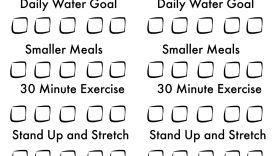Eating Your Way to Better Health: The Live Well Diet

Overview of The Live Well Diet
The Live Well Diet is more than just a plan—it’s a lifestyle shift focused on nourishing the body and mind. By emphasizing whole foods and balanced nutrition, this diet encourages individuals to embrace healthier eating habits. It builds a foundation on essential food groups and teaches individuals how to enjoy food while making smarter choices.
- Eating Your Way to Better Health: The Live Well Diet
- Overview of The Live Well Diet
- Benefits of Eating Your Way to Better Health
- Understanding Nutritional Basics
- Importance of Balanced Diet
- Nutrient-Rich Foods to Include in Your Diet
- Building Healthy Eating Habits
- Meal Planning Strategies
- Tips for Mindful Eating
- Exploring Different Food Groups
- Incorporating Fruits and Vegetables
- Choosing Healthy Protein Sources
- Making Smart Food Choices
- Reading Food Labels
- Avoiding Processed Foods
- The Role of Hydration in Health
- Benefits of Drinking Water
- Hydrating with Herbal Teas
- Understanding Portion Control
- Importance of Portion Sizes
- Strategies for Controlling Portions
- Cooking Methods for Health
- Healthy Cooking Techniques
- Using Herbs and Spices for Flavor
- Incorporating Regular Physical Activity
- Importance of Exercise
- Finding an Exercise Routine You Enjoy
- Mind-Body Connection
- Stress Management Strategies
- Importance of Adequate Sleep
- The Power of Superfoods
- Benefits of Superfoods
- Adding Superfoods to Your Diet
- XII. Seeking Professional Guidance
- Consulting with a Registered Dietitian
- Working with a Health Coach
- XIII. Sustaining Healthy Habits
- Setting Realistic Goals
- Tips for Long-Term Success
- XIV. Recipes for Healthy Living
- Breakfast Ideas
- Lunch and Dinner Recipes
- XV. Conclusion
- Recap of The Live Well Diet
- Embracing a Healthier Lifestyle
Benefits of Eating Your Way to Better Health
Eating healthy can transform not only your physical appearance but also your overall well-being. Here are some benefits of adopting a healthier diet:
- Improved Energy Levels: Nutrient-rich foods fuel your body, keeping energy levels stable throughout the day.
- Enhanced Mood: Certain foods can boost serotonin levels, leading to better mental health.
- Weight Management: Eating well supports maintaining a healthy weight without the need for drastic measures.
- Reduced Risk of Chronic Diseases: A balanced diet can lower the chances of conditions like diabetes and heart disease.
As someone who embraced these principles, I’ve found that making mindful choices has changed my relationship with food, proving that not all diets feel restrictive. Instead, they can be empowering and enjoyable!
Understanding Nutritional Basics
Importance of Balanced Diet
Navigating the world of nutrition can feel overwhelming, but understanding the importance of a balanced diet is the first step toward better health. A balanced diet provides the essential nutrients our bodies need to function optimally. It consists of a variety of food groups that work together to support bodily functions, which can ultimately boost energy and improve mood.
- Fuels Growth and Repair: Helps in maintaining healthy cell function.
- Supports Immune Function: Aids in protecting against illness.
- Promotes Healthy Weight: Balances energy intake and expenditure.
Nutrient-Rich Foods to Include in Your Diet
Incorporating nutrient-rich foods into your meals doesn’t have to be complicated. Here are some great options:
- Fruits: Berries, oranges, and bananas are packed with vitamins and antioxidants.
- Vegetables: Dark leafy greens like spinach and kale are excellent sources of iron and fiber.
- Whole Grains: Quinoa, brown rice, and oats provide essential carbohydrates for energy.
- Healthy Fats: Avocados and nuts are not only delicious but also heart-healthy.
When I started including these foods in my daily meals, I noticed a significant boost in my energy levels and overall well-being. The simple act of diversifying my plate made eating a much more enjoyable experience!
Building Healthy Eating Habits
Meal Planning Strategies
Transitioning from understanding nutritional basics to implementing them in daily life can be a game changer. One effective method is meal planning. By organizing meals ahead of time, you can make healthier choices and save time during busy weeks. Here are a few strategies to get started:
- Create a Weekly Menu: Write down meals for the week, considering your schedule.
- Batch Cooking: Prepare larger portions of meals and freeze them for later.
- Keep a Grocery List: Stick to it to avoid impulse purchases at the store.
Tips for Mindful Eating
Another crucial aspect of healthy eating is mindfulness. It’s not just what you eat, but how you eat that matters. Adopting mindful eating practices can enhance your food experience:
- Slow Down: Take your time with each meal. Chewing slowly allows your body to recognize fullness.
- Eliminate Distractions: Try eating without screens or other distractions to fully enjoy your food.
- Listen to Your Body: Pay attention to hunger and satiety cues, which helps prevent overeating.
Incorporating these techniques has significantly helped me savor my meals more and cultivate a positive relationship with food. Each meal becomes not just nourishment, but an opportunity to connect with what I’m consuming!
Exploring Different Food Groups
Incorporating Fruits and Vegetables
Continuing on the journey toward healthy eating, it’s essential to explore the vibrant world of fruits and vegetables. These food groups are packed with vitamins, minerals, and fiber, making them the cornerstone of any balanced diet. To easily incorporate them into your routine:
- Add to Every Meal: Aim to fill half your plate with fruits and vegetables.
- Snack Smart: Keep pre-washed fruits and cut veggies ready for quick, healthy snacks.
- Experiment with Smoothies: Blend fruits and greens for a nutrient-dense drink.
In my experience, adding just one serving more each day significantly improved my energy and mood!
Choosing Healthy Protein Sources
Protein is another crucial building block of a healthy diet, providing essential amino acids for muscle repair and overall health. When selecting protein sources, focus on quality:
- Lean Meats: Chicken and turkey are excellent options.
- Fish: Fatty fish like salmon are high in omega-3s.
- Plant-Based Proteins: Beans, lentils, and tofu offer great variety and nutrients.
I found that diversifying my protein sources made meals not only healthier but more exciting. By incorporating plant-based proteins, I discovered new flavors and textures in my dishes that I absolutely love!
Making Smart Food Choices
Reading Food Labels
As we deepen our understanding of the foods we consume, mastering the art of reading food labels becomes essential. Labels provide valuable insights into what you’re really eating. Here’s what to look for:
- Serving Size: Understand how much the serving is to gauge portion control.
- Nutritional Information: Check for calories, fats, sugars, and proteins.
- Ingredient List: Aim for shorter lists with recognizable ingredients.
When I began scrutinizing food labels, I was shocked to see how many hidden sugars and additives were in my pantry staples!
Avoiding Processed Foods
In conjunction with reading labels, making a conscious effort to avoid processed foods can vastly improve your diet. Processed foods often contain unhealthy ingredients that can hinder your health journey. Here are practical tips to steer clear:
- Shop the Perimeter: Fresh produce, meats, and dairy are typically found around the store’s edges.
- Cook from Scratch: Preparing meals at home allows you to control ingredients.
- Limit Fast Food: Opt for healthier home-cooked alternatives or wholesome snacks.
I found that limiting processed foods in my diet not only elevated my energy levels but also made my meals more enjoyable, exciting, and full of flavor!
The Role of Hydration in Health
Benefits of Drinking Water
As we continue to explore improving our health, hydration deserves a prominent spotlight. Drinking enough water is fundamental for maintaining overall well-being. Here are some compelling benefits of staying hydrated:
- Boosts Energy Levels: Even mild dehydration can lead to fatigue and decreased performance.
- Supports Digestion: Water aids in breaking down food and absorbing nutrients effectively.
- Promotes Clear Skin: Adequate hydration can improve skin elasticity and reduce dryness.
Since I started prioritizing my water intake, I’ve noticed my energy levels soar, and my skin feels more vibrant!
Hydrating with Herbal Teas
In addition to water, herbal teas are a fantastic way to enhance hydration while enjoying various flavors and benefits. They can be a soothing alternative to plain water and come with their own unique perks:
- Variety of Flavors: From chamomile to peppermint, herbal teas offer delightful options.
- Aids Digestion: Some teas, like ginger or fennel, can help with digestive issues.
- Rich in Antioxidants: Herbal teas are often loaded with compounds that support overall health.
I love curling up with a warm cup of herbal tea, especially after a long day; it’s a soothing ritual that hydrates while providing comfort and health benefits!
Understanding Portion Control
Importance of Portion Sizes
As we continue our journey toward healthier eating, understanding portion control becomes vital. Portion sizes significantly influence how much we consume and can directly impact our health. Here’s why it matters:
- Prevents Overeating: Larger portions often lead to consuming more calories than necessary.
- Promotes Mindfulness: Being aware of portion sizes encourages us to savor each bite.
- Encourages Balanced Nutrition: Proper portions help ensure we’re getting a variety of nutrients without excess.
After realizing how easy it was to overestimate my serving sizes, I gained a newfound respect for portion control!
Strategies for Controlling Portions
Implementing effective portion control strategies can make a significant difference in your eating habits. Here are some tips to help you manage your portions:
- Use Smaller Plates: This simple change can make portions appear larger and help reduce intake.
- Measure Servings: Initially, measuring food can provide a clear understanding of appropriate portions.
- Listen to Your Body: Tune in to hunger cues and don’t force yourself to finish everything on your plate.
By incorporating these strategies, I’ve discovered that I not only waste less food but also feel more satisfied after meals. It truly transforms the way I connect with food!
Cooking Methods for Health
Healthy Cooking Techniques
As we embrace healthier eating habits, how we prepare our food is just as important as what we consume. Opting for healthy cooking techniques can enhance the nutritional value of meals. Here are some methods to consider:
- Steaming: This gentle method preserves nutrients while keeping veggies vibrant and crunchy.
- Grilling: Cooking on a grill allows fats to drip away, resulting in lower-calorie meals.
- Baking: Use the oven for hearty dishes while minimizing added oils and fats.
I’ve personally found that grilling vegetables brings out their natural sweetness, making healthier meals incredibly satisfying!
Using Herbs and Spices for Flavor
To elevate your cooking, don’t underestimate the power of herbs and spices. These flavorful additions not only enhance taste but also contribute various health benefits:
- Fresh Herbs: Basil, cilantro, and parsley offer vibrant flavor without extra calories.
- Spices: Cumin, paprika, and turmeric provide depth and may possess anti-inflammatory properties.
- Creative Combinations: Experimenting with different herb and spice blends can lead to exciting new flavors in your dishes.
Since I started incorporating more herbs and spices, I’ve transformed even the simplest meals into culinary delights without relying on heavy sauces or excess salt. It truly proves that healthy cooking can be both delightful and nutritious!
Incorporating Regular Physical Activity
Importance of Exercise
As we focus on healthy eating, we mustn’t forget that regular physical activity plays a crucial role in our overall health. Incorporating exercise into daily life offers numerous benefits:
- Boosts Mood: Physical activity releases endorphins, which can enhance your mood and reduce stress.
- Improves Heart Health: Regular exercise strengthens the heart and improves circulation.
- Aids Weight Management: Combining exercise with a balanced diet is effective for maintaining a healthy weight.
I’ve noticed that scheduling just 30 minutes of activity each day lifts my energy and enhances my focus throughout the day.
Finding an Exercise Routine You Enjoy
The key to making exercise a consistent part of your life is finding activities you genuinely enjoy. Here are some tips to discover your ideal routine:
- Try Different Activities: Experiment with yoga, dancing, hiking, or swimming to see what feels good.
- Set Realistic Goals: Start small, like a daily walk, and gradually increase intensity or duration.
- Join a Class or Group: Group exercises, such as cycling or Zumba, can make workouts more enjoyable and motivating.
After trying various classes, I found that dance workouts not only keep me fit but also bring joy to my routine, making fitness feel less like a chore and more like a celebration!
Mind-Body Connection
Stress Management Strategies
As we explore the mind-body connection, it’s essential to recognize how deeply stress can affect our health. Effectively managing stress not only contributes to mental clarity but also supports physical well-being. Here are some strategies that have helped me:
- Mindfulness and Meditation: Taking just a few moments for deep breathing or meditation can significantly reduce anxiety.
- Regular Exercise: Physical activity allows the body to release tension and boosts mood through endorphins.
- Connect with Nature: Spending time outdoors has a calming effect that can refresh the mind.
In my experience, incorporating these simple practices has made a world of difference in how I handle daily pressures.
Importance of Adequate Sleep
Another crucial aspect of the mind-body connection is sleep. Quality rest is foundational for both mental and physical health. Here’s why prioritizing sleep is vital:
- Supports Cognitive Function: Adequate sleep is essential for memory, focus, and decision-making.
- Boosts Immune System: It helps the body fight off illnesses more effectively.
- Regulates Mood: Lack of sleep can lead to irritability and poor emotional health.
Since implementing a consistent bedtime routine, I’ve noticed a dramatic improvement in my energy levels and overall mood, proving that a good night’s sleep is just as critical as proper nutrition and exercise!
The Power of Superfoods
Benefits of Superfoods
As we focus on overall well-being, it’s hard to ignore the impressive benefits that superfoods can bring to our diets. These nutrient-dense foods are often packaged with vitamins, minerals, and antioxidants that can help enhance health. Here are some notable benefits:
- Rich in Nutrients: Superfoods provide high concentrations of essential nutrients.
- Boosts Immune Health: Many superfoods support the immune system, helping to ward off illness.
- Enhances Energy Levels: Consuming these foods can improve stamina and vitality.
After incorporating superfoods like berries and quinoa into my meals, I felt a significant boost in my energy and overall health!
Adding Superfoods to Your Diet
Integrating superfoods into your daily meals doesn’t have to be daunting. Here are some simple ways to include them:
- Smoothies: Add spinach, kale, or chia seeds for a nutrient-packed drink.
- Salads: Toss in goji berries, nuts, or sliced avocado for extra flavor and nutrition.
- Snacks: Swap traditional snacks for dark chocolate or hummus made with chickpeas.
I’ve found that experimenting with superfoods has transformed my meals into vibrant and nutritious experiences, making healthy eating not only beneficial but enjoyable too!
XII. Seeking Professional Guidance
Consulting with a Registered Dietitian
As we continue our journey toward better health, seeking professional guidance can be a valuable step. Consulting with a registered dietitian (RD) can provide tailored advice and help address specific dietary needs. Here’s why an RD can be beneficial:
- Personalized Nutrition Plans: They create meal plans that cater to individual lifestyle and health goals.
- Addressing Health Conditions: Dietitians can offer strategies for managing conditions like diabetes or high cholesterol.
- Evidence-Based Advice: RDs rely on scientific research to suggest the best dietary practices.
When I worked with a dietitian, I gained profound insights that transformed my eating habits and made me feel more confident.
Working with a Health Coach
In addition to dietitians, partnering with a health coach can enhance your wellness journey. Health coaches provide support and motivation to help you achieve your goals:
- Goal Setting: They assist in setting achievable goals and creating actionable plans.
- Maintaining Accountability: Regular check-ins help keep you on track toward your health aspirations.
- Building Healthy Habits: Coaches can offer strategies to instill lasting lifestyle changes.
My experience with a health coach allowed me to dive deeper into my motivations, turning challenges into sustainable habits that aligned with my health journey. Finding the right support can make all the difference!
XIII. Sustaining Healthy Habits
Setting Realistic Goals
As we embark on the path of transforming our lifestyles, the importance of setting realistic goals cannot be overstated. Achievable goals lay the foundation for lasting change. Here’s how to set them effectively:
- Be Specific: Rather than saying “eat healthier,” try “add one serving of vegetables to each meal.”
- Use Measurable Criteria: Track progress to stay motivated, like logging workouts or meals.
- Time-Bound Objectives: Set deadlines for your goals to create a sense of urgency.
In my journey, starting with small, attainable goals helped me build confidence and set the stage for larger changes.
Tips for Long-Term Success
To ensure those healthy habits stick, consider these tips for long-term success:
- Create a Support Network: Surround yourself with friends, family, or online communities for encouragement.
- Stay Flexible: Life can be unpredictable, so adapt your plans as needed without feeling defeated.
- Celebrate Milestones: Acknowledge your achievements, no matter how small, to maintain motivation.
I’ve found that celebrating my personal milestones not only enhances my motivation but also turns the journey into a rewarding adventure. Sustaining healthy habits is a lifelong commitment, but with the right strategies, it can also be incredibly fulfilling!
XIV. Recipes for Healthy Living
Breakfast Ideas
Having a nutritious breakfast can set a positive tone for the day. Here are some delicious breakfast ideas that fuel both the body and mind:
- Overnight Oats: Combine rolled oats, Greek yogurt, almond milk, and your favorite fruits. Prepare the night before for a quick grab-and-go option.
- Smoothie Bowl: Blend spinach, banana, and almond milk, then top with nuts, seeds, and berries for added crunch and flavor.
- Avocado Toast: Spread ripe avocado on whole-grain bread and top with poached eggs and a sprinkle of chili flakes for a protein-packed start.
I absolutely love my smoothie bowls; they’re both refreshing and visually satisfying!
Lunch and Dinner Recipes
For lunches and dinners, simple yet wholesome meals can be delicious and satisfying:
- Quinoa Salad: Mix cooked quinoa with black beans, cherry tomatoes, diced cucumbers, and cilantro for a protein-rich dish. Drizzled with a lime vinaigrette, it’s refreshing and fulfilling.
- Stir-Fried Veggies & Chicken: Sauté an assortment of colorful vegetables with chicken breast in olive oil and add soy sauce for flavor. Serve over brown rice or quinoa for a complete meal.
- Zucchini Noodles: Substitute traditional pasta with spiralized zucchini and toss with marinara sauce, grilled shrimp, or turkey meatballs.
These recipes have been staples for my meals, making it easy to embrace healthy eating while enjoying every bite!
XV. Conclusion
Recap of The Live Well Diet
As we wrap up our exploration of The Live Well Diet, it’s important to remember that this journey goes beyond simply changing what we eat. It’s about embracing a holistic approach to health and wellness that includes nutrition, physical activity, and mindfulness. Key takeaways include:
- Balanced Nutrition: Focus on incorporating a variety of whole foods, including fruits, vegetables, lean proteins, and healthy fats.
- Lifestyle Adjustments: Making small, sustainable changes in your daily routine is crucial for long-term success.
- Seek Support: Don’t hesitate to reach out for professional guidance when needed.
Embracing a Healthier Lifestyle
Embracing a healthier lifestyle is a rewarding journey filled with growth and discovery. By prioritizing nutritious food, regular physical activity, and effective stress management, we can enhance our quality of life. Reflecting back, I started this adventure with small changes that eventually led to significant improvements. Celebrate each step along the way, and remember that every positive choice contributes to a healthier and happier you. It’s never too late to begin this transformative journey!





